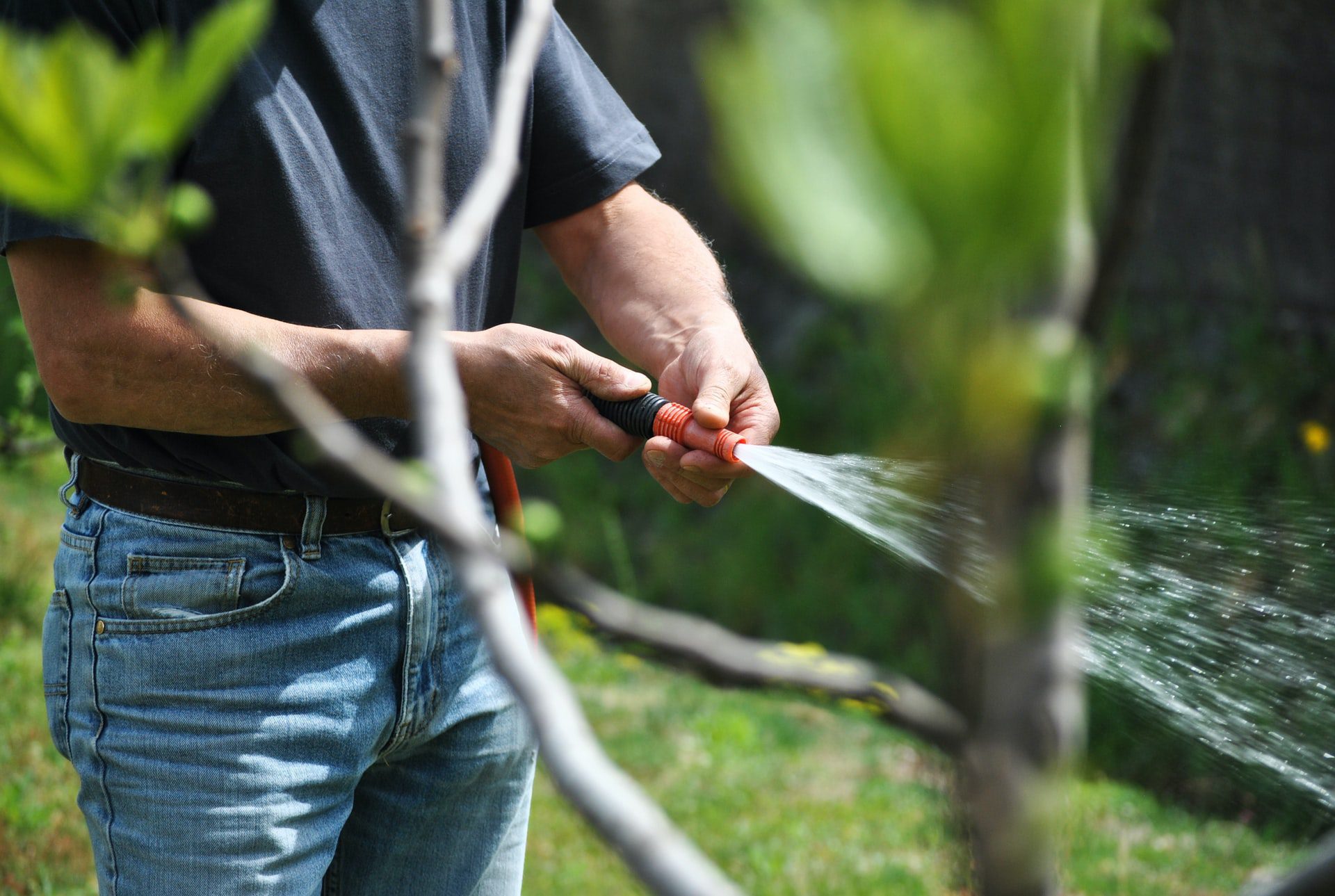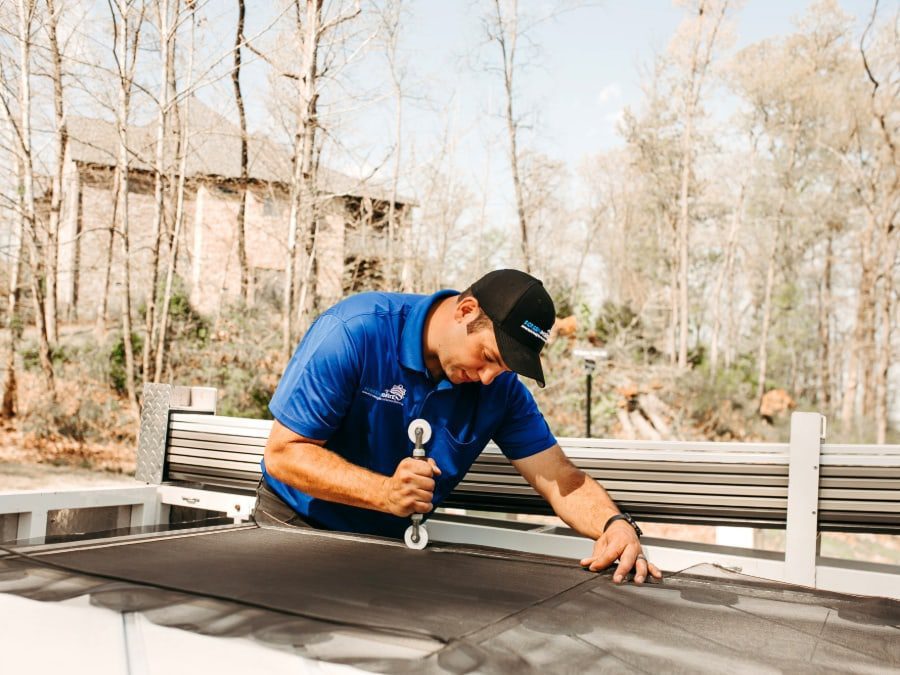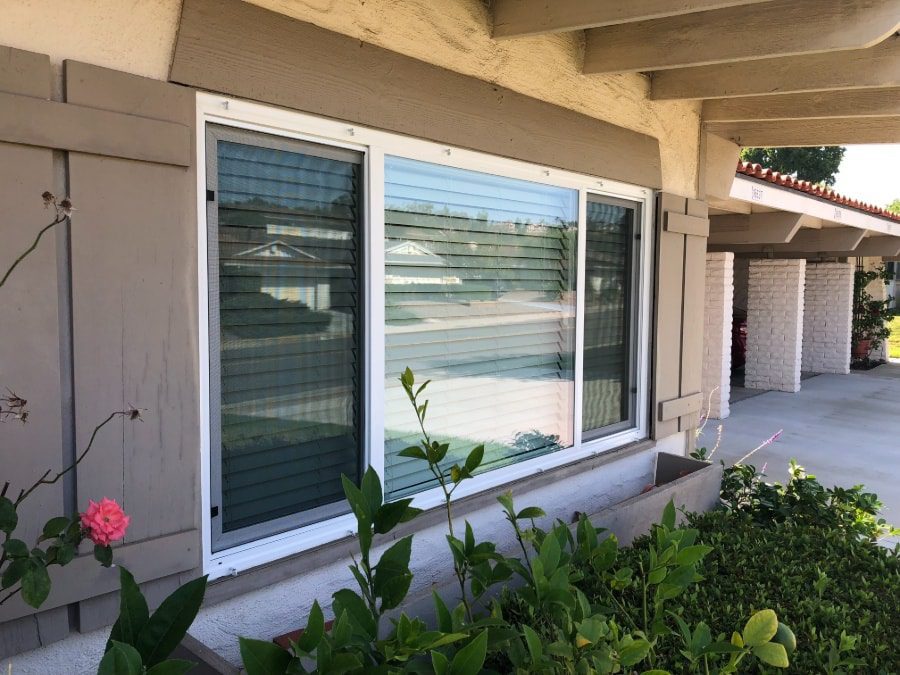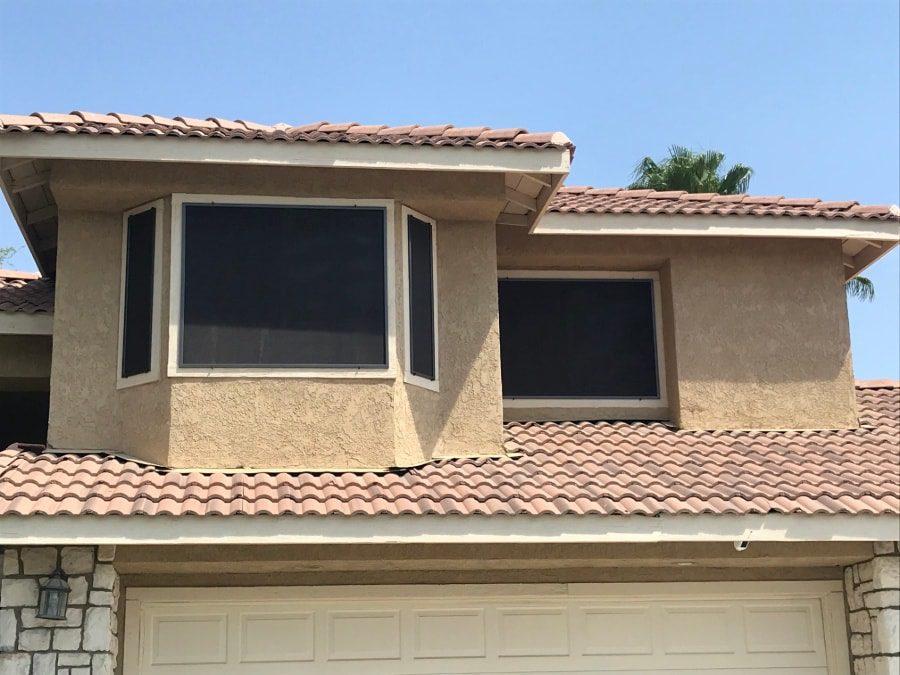
How to Clean Window Screens
We’ve all fallen victim to spending time cleaning windows, only for them to still look dirty because of dust and debris caught in the window screens. Window screens tend to be an overthought for most homeowners. Not only are they little details in a home, but the process of how to clean window screens can be foreign to most people.
A common hack most people use for cleaning their window screens is simply vacuuming the dust off the surface, but this is only fixing the aesthetic of the screen. If you are looking forward to opening your windows to let in a nice summer breeze, you need to learn how to properly clean your window screens and how often to clean them.
Why You Should Clean Your Window Screens
Cleaning your window screens regularly is a good practice to maintain good air quality inside your house. When you open your windows for the first time of the year, there may be more particles flowing into your home other than fresh air.
During the winter months, moisture and bacteria gather on your window screens and create unhealthy particles, even mold. Black mold can be found on window sills and screens if they are not regularly cleaned. This type of mold usually goes unnoticed, but it can cause or irritate infections, allergies, asthma, and other respiratory illnesses once inside your house. People with preexisting respiratory issues may become sick due to mold particles in the air. Mold can also cause musty odors and leave stains on walls and furniture.
Cleaning your window screens means you are killing off any unwanted bacteria and eliminating dust particles that would otherwise drift into your home and contaminate your air.
How Often You Should Clean Your Screens
Learning how to clean window screens is a great skill to have, but it goes to waste if you don’t know how often you should clean your screens.
The frequency at which you clean your screens depends on your location and climate. If you live in a windy environment where debris and dust are more susceptible to blowing against your windows, you will want to clean your screens more regularly, about 2-3 times a month. If you live in a drier location with less wind, you can get away with cleaning your screens once a month.
You should deep clean your screens when you first open your windows after the winter season to get rid of mold and dirt that might have built up. In the spring season, you should clean your screens more regularly as pollen particles will get trapped.
If you are unsure how often you should clean your screens, a good rule of thumb is to clean your window screens as often as you clean your windows. If you clean your windows and do not clean your screens, the dirt on the screens is more likely to muddy up your newly cleaned windows.
How to Clean Window Screens
If this is your first time cleaning, you need to know the proper steps on how to clean window screens. Before you start, you should make sure your window screens are free of any damages and not in need of repairs. If you have any old screens, it’s better to replace them once they’ve reached their expired shelf life.
Start cleaning your window screens with these steps:
Step 1. Remove your window screen from the frame.
If you are cleaning your window screens for the first time of the year, you will want to remove them from the frame to properly clean and disinfect them. This allows you to clean the screen, the frame, and the window sill of all dirt and mold that might be growing.
Step 2. Mix a cleaning solution.
There are plenty of cleaning solutions on the market for cleaning windows. Professionals may use a specialized cleaning product, but if you are cleaning your window screens yourself, mixing 1/4 cup of all-purpose dish soap with 1/2 gallon of water will do the trick.
Step 3. Scrub the window screen with a brush and cleaning solution.
Using a brush with soft bristles will suffice for this step. However, it is recommended to use a specialty window screen cleaning brush. After mixing your cleaning solution, gently scrub away all dirt and particles from both sides of your screen using the brush and cleaning product.
Step 4. Rinse the screen using warm water.
Lay the screen flat and rinse all dirt and suds off the screen and frame using warm water. Make sure the water pressure isn’t too high, so you don’t damage the screen.
Step 5. Let the window screen dry and replace it in the frame.
Once you’ve properly cleaned your window screen, lay it on a clean flat surface and allow it to completely dry. Once it is dry, replace it in the frame.
How to Clean Window Screens Without Removing Them
If you don’t have the space to take your window screens out of their frames, or you aren’t cleaning them for the first time of the year, there are ways you can clean your window screens without removing them.
The best way to clean your window screens while keeping them in the frames is lightly cleaning the surface with a soft vacuum, lint roller, magic eraser, or toothbrush. You can also pressure wash the screens, spray them with vinegar, or saturate them with a cleaning solution. Just make sure to aim outside or keep your window closed to protect the interior of your house.
Repair or Replace Any Old Window Screens
Like anything in your house, window screens need to be properly maintained. Before you start cleaning your window screens, assess them for any damages or signs they are exceeding their shelf life.
Broken screens can cause more harm than good, letting in pests and unwanted debris. Worn-down screens that need replacing or repairs should be handled appropriately by a screen professional.

5 Benefits of a Three Season Room
If you’re yearning to relax in the beauty of your backyard or natural living space without being bothered by pests or intense climates, adding a three-season room to your home is the best solution.
What is a three-season room? These featured spaces are an upgraded version of basic patio enclosures. Three season rooms are additions built onto houses enclosed with glass. The purpose of these enclosures is to create a relaxing environment with floor-to-ceiling windows to experience the natural environment surrounding its occupants while keeping them protected from harsh climates and pests. While most three-season rooms are a form of patio or porch, they can also enclose a simple section of yard space.
Three-season rooms offer the perfect space for you to relax on comfortable furniture and take in nature’s beauty without worrying about damage caused by outdoor elements. But why invest in a three-season room over other enclosed outdoor spaces?
Here are five benefits of a three-season room.
Expands Your Living Space
One of the most noticeable benefits of having a three-season room is the expansion it gives your living space. Because three-season rooms are open and inviting spaces with plenty of natural light, homeowners tend to use the expansion as a gathering place.
It’s a proven fact that being surrounded by nature and natural light improves your mood. Adding a three-season room gives you the perfect space to walk from your living room to a clean and enclosed space that is still immersed in the natural environment surrounding your house. The purposes this room can provide are endless. Allow young children a safe space to play in the sun or lounge on a loveseat while watching the sunset.
If you’re looking to expand your house without paying for complete structural renovations, a three-season room can be the perfect addition to your living space.
Adds Protection
Upgrading your patio or yard to include a three-season room offers the benefit of more protection over your indoor/outdoor space. You can enjoy nature in your enclosed space without being bothered by pests or weather changes.
If you were to bask in the beauty of nature while fully exposed to the elements, it might still be enjoyable, but you would be at risk of sunburns, mosquito bites, or possible rainfall. A three-season room gives you the luxury of being outdoors without actually suffering from outdoor elements.
The main difference between enclosed patios and three-season rooms is the screens used to line them. Enclosed patios use mesh screens, while three-season rooms use clear or tinted vinyl panels. This allows three-season rooms to be enjoyed in much more diverse climates than patio enclosures because they can better protect the interior from rainfall and debris.
These enclosed rooms will not only protect you and your guests but your furniture too. You don’t have to worry about excessive rusting, fading, or breaking, usually when furniture is exposed to the outdoor elements.
Various panels are available when building your three-season room, such as clear vinyl or shades that block out UV light or outside air particles. This design is the perfect solution if you want to experience spring blooms while having pollen allergies or those who want to bask in the sunlight without getting a sunburn.
Adapts to Each Season
The greatest advantage three-season rooms present over traditional patio enclosures is the ability to enjoy the space year-round—depending on your location’s climate.
Three-season rooms are praised by those who live in areas where it doesn’t get too hot in the summer and too cold in the winter. They give you more freedom to use the space in ways that screened patios would not, such as decorating with perishable furniture without having to worry about sun and rain damage. If you live in a location where the winters are cold and snowy, this room might not be the one most people gravitate toward in the colder months, but you can rest well knowing all the materials and occupants in that room will be safe. If you still want to feel a warm summer breeze throughout your room, simply open the windows and doors to let in the fresh air.
If you are looking for space you can confidently enjoy year-round, consider investing in a three-season room in which you control the heating and cooling inside the room.
Doesn’t Break Your Budget
Adding a more durable patio enclosure might sound like it’s going to exceed your budget, but three-season rooms can be very cost-effective.
The labor put into building three-season rooms is very minimal as it does not require a foundation, insulation, or plumbing and heating systems. The only element needed is an anchored deck.
If you are looking to eliminate your labor budget completely, there are options for three-season room kits available on the market. These kits allow you to erect your own three-season room on a budget.
Keep in mind, if you choose to construct your own three-season room, there are a few difficulties that accompany DIY. Choosing a three-season room kit allows much more room for error in your construction. If you are not savvy with heavy crafting, you could spend more money trying to correct the mistakes you made the first time around. Hiring a service to build your three-season room guarantees you can relax while everything is done right the first time and all at once.
The most expensive part of building your three-season room will be choosing the materials you would like to use. Porch screens and glass panels vary in pricing and can change your space’s purpose. You can also choose to fully carpet your three-season room and add any intricate details.
Regular patio covers or deck covers can be customized into a three-season sunroom if you want. This is an excellent way to upgrade an existing feature of your home.
Adds Versatility to Your Patio Enclosure
Three-season rooms are an extremely versatile space in your house. You can use them as a traditional patio enclosure gathering space or get creative by crafting a sunroom.
Three-season rooms are a type of sunroom when constructed for that purpose. This can be a great place to have an indoor green room with a plant collection or lounge space for warm days. If you already have a regular patio cover or deck cover and would like to turn it into a three-season sunroom, the only step is to add glass-paneled walls to surround the space.
Three-season rooms offer an array of benefits to your home. If you’re looking to add an upgraded patio enclosure or sunroom addition to your living space, you don’t have to limit yourself to using it for the traditional family room purpose. Consider turning it into an indoor/outdoor gym, game room, or green room. Whatever the goal, enjoy the outdoor scenery while protected by your enclosed space.
Get started by contacting your nearest Screenmobile pro and get started on your home renovation project.

Pros and Cons of a Motorized Screen
Backyard patios and decks are genuinely wonderful ways to enjoy the fresh air and outdoors and serve as liaisons between the comfort of your home’s interior and nature’s beauty. Porch screens, on the other hand, can be polarizing backyard features. Some homeowners don’t mind or even notice porch screens. Others hate them, viewing them as distracting barriers to the outside world.
Depending on where you live, window and porch screens are necessary for three months out of the year when you’re sharing space with pesky mosquitoes. Some homeowners don’t mind or even notice porch screens because the latest deck screening technology is so transparent. However, some don’t want anything they deem obtrusive in their outdoor spaces.
Enjoy the Best of Both Worlds with A Motorized Screen
What if there’s a product that offered the security of a screened-in deck or patio without the drawbacks? If you could enjoy insect protection without sacrificing your curb appeal, would you be interested? A motorized screen, or roll-down screen, is the answer.
A motorized screen is an innovative system designed for flexibility and functionality. Motorized porch screens, such as Sunair, Phantom Screens, and Sun Control Retractable Shades, can be lowered or retracted with a button’s press using a motorized screen system. Instead of settling for one set configuration, you can customize your deck to fit the weather, season, and even your mood.
We custom design every motorized screen system, and they are guaranteed to fit the correct length no matter where they’re installed. Each screen is finished with a weighted bar to keep them in place.
You can select various fabric and screen options that can highlight or blend into your home’s decor and choose from different mesh textures and styles to offer the right coverage for your needs.
The Benefits of a Motorized Screen
Still not convinced? If you install a motorized screen system, you’ll enjoy:
Cooler temperatures, on demand.
Using roll-down screens will block unwanted sunlight and help keep your deck or patio at a comfortable temperature. This means you’ll enjoy the space more, even in the heat of summer. Windows screens can even help regulate the temperature of your home.
Protection from insects and weather.
With a motorized screen, you can keep the pesky flies and mosquitos out during spring and summer for a more relaxing time enjoying your outdoor space. Retractable screens can also protect your furniture and other decor items from the sun’s UV rays.
Energy savings.
Retractable screens can help save money on your utility bills. With motorized retractable screens deployed, less sunlight will enter your home during the hotter months, reducing the workload on your air conditioner. The opposite can work during winter months, when retracting the screens allows more natural sunlight into the home.
They increase the value of your home.
Roll-down screens are often very popular with home buyers. Potential buyers can enjoy all the benefits of permanent screens with the visual appeal of hiding them. A retractable screen could also boost your home’s value during appraisal.
Customizable and elegant.
The motorized screen’s housing is customizable and incredibly sleek. Each housing can be custom painted to achieve the look that is just right for your home. Show off the beauty of your deck, patio, or home without harming curb appeal.
Top-of-the-line automation.
Today’s motorized screens are incredibly user-friendly and easy to use. Aside from the effortless push-button controls, you can adjust your roll-down screens to work entirely on their own. Options like Phantom Shades include sun and wind sensors that automatically drop or lower the shades when the light percentage hits a set threshold.
Custom options for any space.
Screenmobile doesn’t just screen decks and patios. Whether you need a complete set of window screens, a door covering, or even a pergola or gazebo, there is a motorized screen option that has you covered. Our team can make your dream come true.
Cons of Motorized Screens
- Require a larger investment. Retractable screens are considerably more expensive than fixed screens. For this reason, people are more selective of where to install motorized screen systems. Porches and patios are popular choices because they offer the most usable space and flexibility.
- More moving parts. Motor screens have several moving parts, which means there will be several things to adjust if they stop functioning correctly. It’s likely best to call for professional help with a non-functioning screen.
There’s no reason to settle for anything less than the best when Screenmobile offers so many customizable options and services. When you’re ready to enjoy the best of both worlds with motorized screens or transform the look and efficiency of your home, give us a call or check out our free estimator. We have highly trained Screenmobile Service Technicians across the country ready to help.

How to Choose The Right Window Screen Material
Window screens may not be a feature in your house that has caught your attention—unless they’re a source of annoyance. Screens tend to be considered not as important for new homeowners, but choosing the right window screen material for your space can enhance your environment.
During the warmer seasons, screens make it possible for us to open the windows and welcome in the summer breeze. The right window screen material for a given room can invite in more natural light, defend against intruding pests, and cycle in the fresh air.
But how do you know which type of material is best suited for your windows?
Here are a few factors to consider when choosing your window screen material.
Choosing the Right Window Screen Material
Before you start purchasing your new window screens, you need to survey the space they’re going to inhabit. Not every material is compatible with every environment. Your screens may be put through wear and tear you aren’t anticipating, which can increase the likelihood of replacing them faster.
Are you looking for increased natural airflow in your space? Then proper ventilation is a factor you should value in your screen material. There are plenty of insect screens that offer larger mesh sizes without having to sacrifice protection from pests. Ventilation is an essential factor if you are looking for porch screens that act as a protective shield to outside disturbances while still allowing sunlight and fresh air to filter through.
Where are you located? Screens are not a one-size-fits-all product. There are different material types, and some might not be compatible with the climate you are in. If you are in a coastal climate, require water and rust-resistant materials. On the other hand, if you live in a windy climate that experiences flying debris, Tuff screens could be a better option for their durability.
Do you value expansive views and outward visibility? Maybe you have indoor plants that need a lot of sunlight. Transparency in your window screens is a factor that can be overlooked. If you are looking to let in more natural light and reduce the visual barrier between your indoor and outdoor space, look for materials that have high transparency.
The most important part of choosing your window screens is the style and material you will use. Keeping the prior factors in mind, you will choose which material best suits your location and intended use for your screen material.
Fiberglass Screen
Fiberglass is perhaps one of the most common materials used in window screens.
Fiberglass screens are commonly used in residential and commercial properties because it is lightweight and does not corrode or rust. Fiberglass is also a very versatile material and can be sized for various projects. It is proficient at keeping bugs out while allowing air and natural sunlight to flow into a room. Unlike aluminum, fiberglass will become flat again if bent or dented. Fiberglass screens are an affordable option for replacement window screens.
On the other hand, fiberglass is not the most durable window screen material. It will stretch over time, needing to be replaced more often than aluminum. It is also more prone to tearing.
Fiberglass can also be used for other projects such as pool cages and enclosures.
Pet Resistant Screens/Tuff Screens
Everyone loves their pets. No one loves their pets destroying their screens. These heavy-duty pet-resistant screens designed to put up with the rough treatment your pet may dish out from time to time. The size of your pet and the damage that he or she causes will determine the best screen to fit your needs. Animal resistant screens give everyone a sense of ease knowing they will not have to replace screens every time one of their furry friends gets a little too rough or excited when they see you out the window.
The three most popular types of pet-resistant screens are Pet Screens, Tuff Screens, and Super Screens.
Other premier pet products include quality heavy-duty dog doors and cat doors, and screen guards that are a barrier between your pets and your screens.
Solar Screening
Are you looking to limit the amount of sunlight your windows let in? Consider using solar screens for your space.
Solar screens are perfect for windows that attract a lot of heat and sunlight. Their dark exterior blocks out the heat of the sun, absorbs excess heat, and provides additional privacy. Solar screening is an excellent option for cutting down air conditioning costs and protecting valuable furniture from fading with sun exposure.
This screen material reduces natural light by 30-40%, which can be harmful to indoor plants or animals that enjoy the sunlight. Although they are more pricey than your typical fiberglass screens, they offer incredible benefits to the home.
If you have west-facing windows that struggle against the beating sun, or your air conditioning bill is too high, solar screens are a great solution. They are mainly used on patios, porches, pool decks, and in warm climates.
Explore some solar screen options, including various colors and styles.
Coated Polyester
For any specialty screens that need to be reinforced with extra strength, coated polyester screens are the best choice.
Coated polyester acts as a protective barrier not only to insects and debris, but against heavy objects as well. If you have issues with your pets tearing apart your current sliding screen doors, coated polyester acts as a tough pet screen replacement. It is also a great material to use in cold climates. The material repels moisture so it can’t be damaged by freezing temperatures.
This screen material is more expensive than your standard fiberglass, but it is not replaced as quickly. Coated polyester is commonly used in sliding screen doors, low windows, and cold locations.
Before purchasing your replacement window screens, keep in mind the necessary factors that will enhance your space. Choosing the wrong screen material could mean spending more money on repairs or replacements and not enjoying the atmosphere. But if you take your time to consider your window screen material options, you can transform your space and invite in your optimal climate.
Common uses for coated polyester screens include:
Animal and Pet Resistant Screens
The Screenmobile Difference
Screenmobile Service Technicians are courteous and always provide a professional experience. We understand that each customer has different needs when providing a service. We tailor our services to meet your needs and exceed your expectations.
Get a free estimate and get started with your home improvement project.








